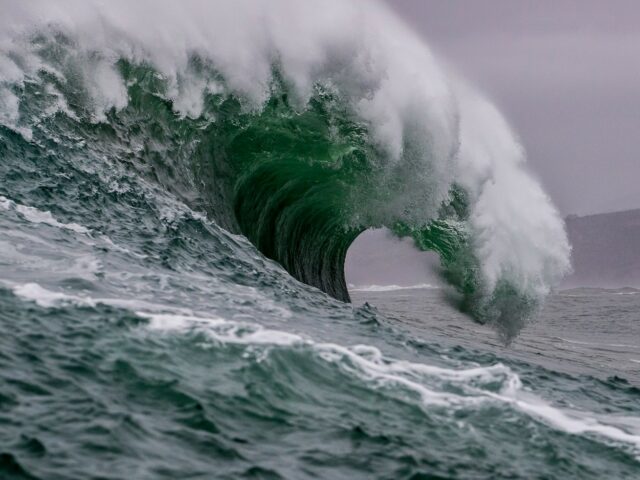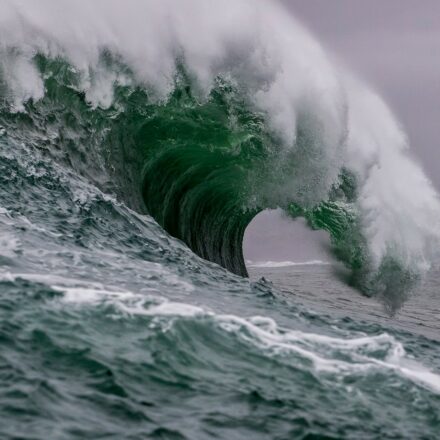By Chris Hayhurst, contributor
It was somewhere in the ocean off West Antarctica that Jack Pan had an epiphany.
A Ph.D. candidate in polar oceanography at the time, Pan was doing maintenance on the electronics-equipped buoys he used to collect data for his research. The solar panels and batteries that powered the bobbing devices were in constant need of cleaning in the turbulent sea.

“It just kind of hit me as these giant waves were smashing the ship,” he recalls. “Like, why were we using batteries and solar when we could get all the energy we needed right from the water?”
Fast-forward five years, and Pan today is the founder and CEO of Ocean Motion Technologies. Based in San Diego, the company makes devices that generate power by converting wave energy into electricity. The small-scale units can easily be installed on nearly any data float and are designed to require very little upkeep, which makes them cost-effective for challenging marine applications.
“It’s essentially a bunch of appendages that hang off the buoy and leverage the differential between wave crests and troughs,” Pan explains. Once those mechanical arms are moving, “you can use clever electronics and hardware to create a circular motion and spin a small generator.”
In a typically wavy sea, the devices can produce around 100 to 300 watts continuously, Pan says. “That doesn’t sound like a lot, but the instruments on these buoys might only need half a watt of power. With 100 watts, that’s practically revolutionary—it allows you to add a huge suite of data tools and sensors.”
Oceans of potential
Ocean Motion, which has six employees, isn’t alone in its mission to harness power directly from the sea. Driving interest in the field is climate change, of course, and the pressing need for alternative energy sources that are clean, consistent and reliable. There’s also the burgeoning blue economy and the emergence of programs like the Defense Advanced Research Projects Agency’s (DARPA) Ocean of Things program that promises to drastically expand the world’s network of floating sensors.
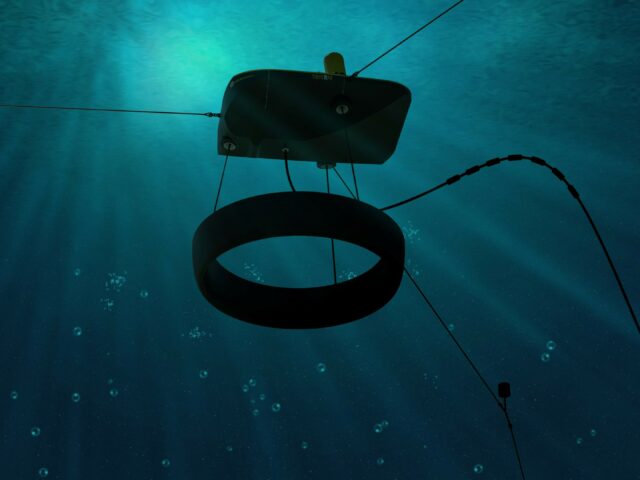
Chris Ostrander, executive director of the Marine Technology Society, says he’s not surprised that entrepreneurs like Pan are developing new tools to tap power from the sea. “I think the ocean captivates people as this iconic and Eden-like limitless source of clean energy,” he notes. “There’s just so much incredible potential; the problem is that it comes with all kinds of hurdles.”
Among them: Wave energy must be affordable to complement and compete with technologies like wind and solar, Ostrander explains. Environmental considerations are also critical—some worry, for example, that wave-tech expansion could litter the Earth’s oceans with floats and cables—and then there’s the related challenge of developing wave energy at scale.
“That’s probably the hardest part,” Ostrander says, noting that supplying power to a data buoy is quite different than doing so for an entire city. “With wind, you can put up a giant turbine, and the bigger it is, the more energy you produce. It doesn’t really work that way on the wave side. To get more energy out of these technologies, you basically have to put more stuff in the water.”
The ocean captivates people as this iconic and Eden-like limitless source of clean energy. There’s so much incredible potential; the problem is that it comes with all kinds of hurdles.
—Chris Ostrander, executive director, Marine Technology Society
Rising (and falling) to meet world energy demands
Such concerns didn’t stop a company called Wavegen from installing (and later decommissioning due to financial and infrastructure setbacks) the world’s first commercial wave-energy device on the Scottish island of Islay in 2000, and it’s not stopping others from developing innovative solutions they hope will find a place in power production today. One such company, Oakland-based CalWave, cites reports from organizations like the Intergovernmental Panel on Climate Change that estimate wave power could provide up to 30% of the world’s energy needs. (The U.S. Energy Information Administration has estimated that waves off the U.S. coast alone could theoretically produce approximately 2.6 trillion kilowatt-hours of energy annually.)
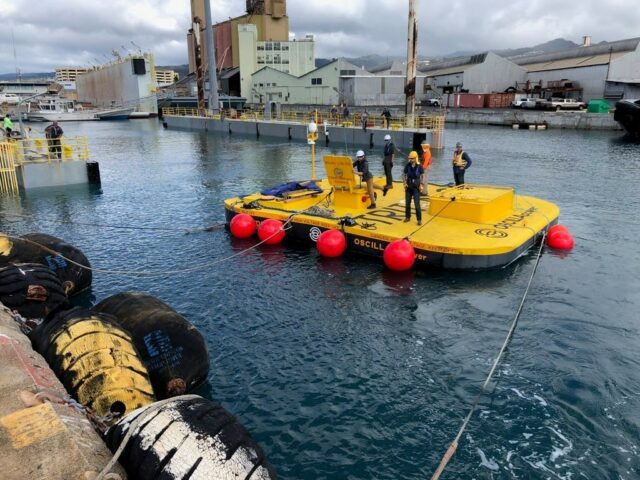
“People are always saying that wave energy has been tried before, that history shows it doesn’t work,” says CalWave Co-founder and CEO Marcus Lehmann. “Well, the technology we’re using and the approach that we’re taking look a lot different than what we’ve seen in the past.”
CalWave recently concluded a pilot program with one of its devices that showed it could operate for 10 months straight in the ocean waters off the coast of San Diego. The x1, as the unit is called, survived several major storms while successfully delivering power via underwater cable to a land-based research station at the Scripps Institute of Oceanography.
Lehmann says the company’s solution is “highly scalable and cost effective,” and unique in that it’s designed to function while fully submerged. The octagonally shaped, raft-like device can be towed into position with a small boat and then moored securely to the ocean floor. All three models CalWave produces run almost entirely autonomously and, once operational, can generate anywhere from 100 kilowatts to 1.6 megawatts of electricity.
“They’re classified as pressure-differential devices,” he explains. The units operate much like an electric car that uses regenerative braking to recharge its battery: As wave pressure sends the device in one direction, it automatically counters with an opposing force that slows down its movement. “It allows us to capture energy from multiple degrees of freedom, and that’s what makes it so efficient.”
Adding waves to the “renewables mix”
Efficiency is also the focus of Seattle-based Oscilla Power, where Tim Mundon serves as CTO. A scientist and engineer by training, Mundon is developing the company’s Triton wave energy converter, which is designed to be installed in utility-scale arrays.
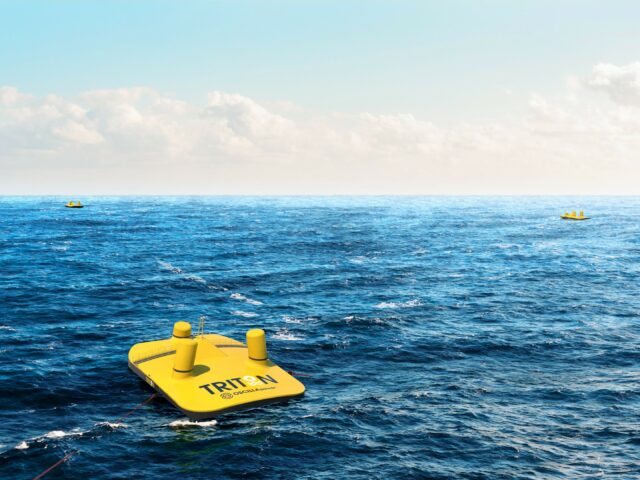
Founded in 2009, Oscilla Power works to extract energy from ocean waves to substantially impact global carbon emissions, Mundon says. “The big picture is that, even with the expected implementation of solar and wind, we’ll still be making 44% of our electricity from fossil fuels by 2050,” the year scientists agree the world must reach net-zero emissions to minimize the impacts of climate change. “It’s our view that there needs to be another renewable in the mix and that waves are the perfect solution.”
Their device, Mundon explains, is a “two-body multimode point absorber.” One part of the system sits on the water’s surface, while a second section hangs beneath. The two parts are tethered by three cables, “and as the waves move the float, they pull against that hanging object, and that causes three drive trains to turn and generate power.”
In truth, there’s a lot more to it, Mundon says, but in general, the physics are simple. The Triton is designed to sit offshore in water that’s at least 50 meters deep. It’s currently being tested at a site in Hawaii, and similar models will soon be installed in Oregon at the U.S. Department of Energy’s PacWave wave-energy testing facility.
There needs to be another renewable in the mix and waves are the perfect solution.
—Tim Mundon, CTO, Oscilla Power
The company is close to its first commercial installment, but Mundon says it could be some time before Triton units are producing energy at the scale it envisions. “We’re getting there, we’re proving the technology—and we’re definitely excited about what’s ahead.”
Lead image courtesy of Todd Turner/Unsplash.
